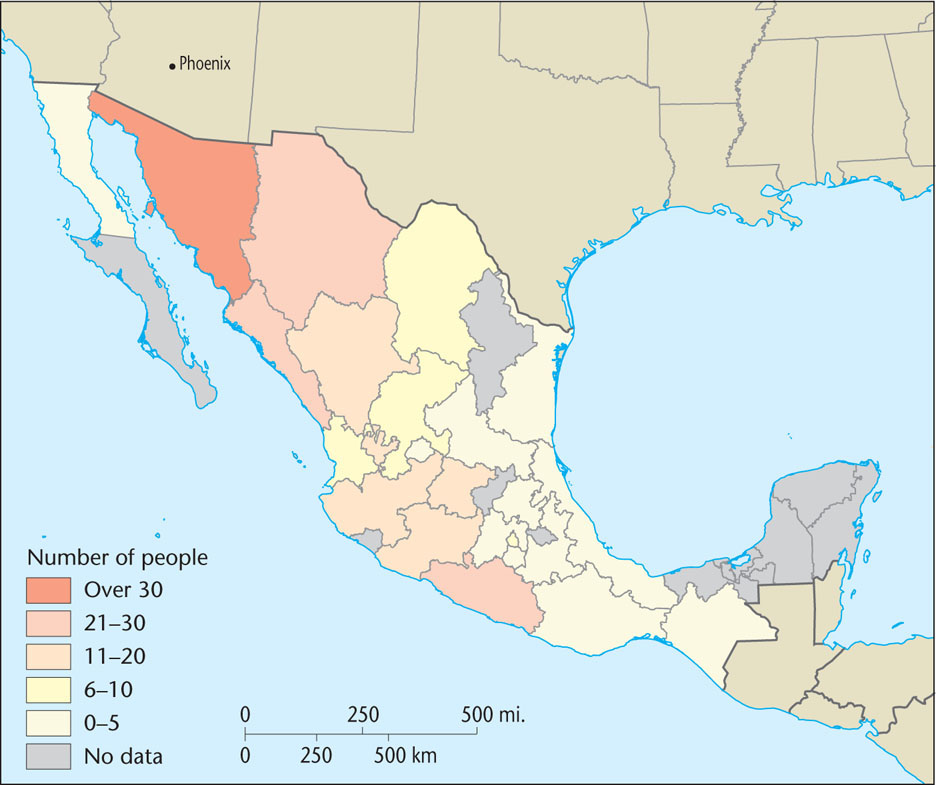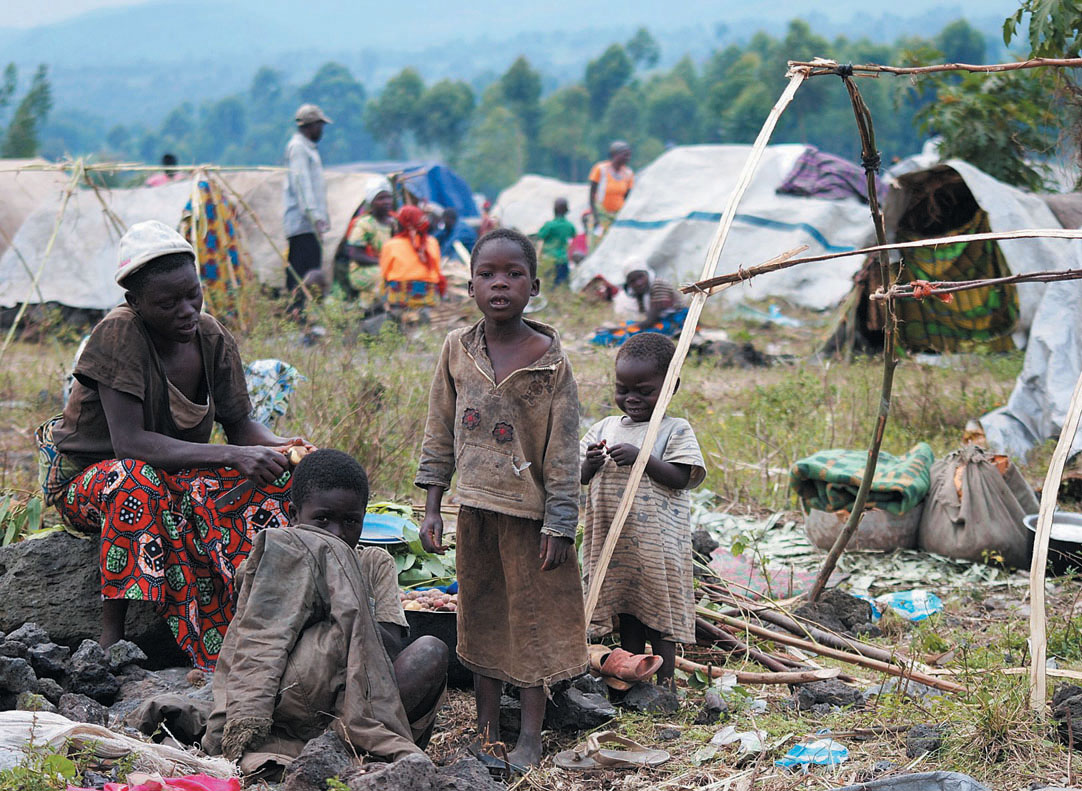Cultural Diffusion and Ethnicity
Cultural Diffusion and Ethnicity

How do the various types of cultural diffusion—relocation, hierarchical, and contagious—help us understand the complicated geographical patterns of ethnicity? Do ethnic homelands, islands, ghettos, and neighborhoods result from different types of diffusion? When groups move, how do cultural patterns reassemble in new places? As noted in the introduction to this chapter, it is often through migration that a group formerly in the majority becomes, in a new land, different from the mainstream and is thus labeled as ethnic or racialized. The many motives for migration can have different results in terms of where a group chooses to go, which parts of their original culture relocate and which do not, and who may become their neighbors in their new home.
Migration and Ethnicity
Migration and Ethnicity
Much of the ethnic pattern in many parts of the world is the result of relocation diffusion. The migration process itself often creates ethnicity, as people leave countries where they belonged to a nonethnic majority and become a minority in a new home. National Geographic’s Genographic Project uses DNA samples from volunteers worldwide to substantiate the claim that all humans descended from a group of Africans who began to migrate out of Africa about 60,000 years ago. The contemporary global mosaic of ethnic populations can be traced to their specific journeys. Today’s voluntary migrations have also produced much of the ethnic diversity in the United States and Canada, and the involuntary migration of political and economic refugees has always been an important factor in ethnicity worldwide and is becoming ever more so in North America.
133
chain migration The tendency of people to migrate along channels, over a period of time, from specific source areas to specific destinations.
Chain migration may be involved in relocation diffusion. In chain migration, an individual or small group decides to migrate to a foreign country. This decision typically arises from negative conditions in the home area, such as political persecution or lack of employment, and the perception of better conditions in the receiving country. Often ties between the sending and receiving areas are preexisting, such as those formed when military bases of receiving countries are established in sending countries. The first emigrants, or “innovators,” may be natural leaders who influence others, particularly friends and relatives, to accompany them in the migration. The word spreads to nearby communities, and soon a sizable migration is under way from a fairly small district in the source country to a comparably small area or neighborhood in the destination country (Figure 5.19). In village after village, the first emigrants often rank high in the local social order, so hierarchical diffusion also occurs. That is, the decision to migrate spreads by a mixture of hierarchical and contagious diffusion, whereas the actual migration itself represents relocation diffusion.

Thinking Geographically
Question
How does this pattern demonstrate distance decay?
involuntary migration The forced displacement of a population, whether by government policy (such as a resettlement program), warfare or other violence, ethnic cleansing, disease, natural disaster, or enslavement. Also called forced migration.
ethnic cleansing The removal of unwanted ethnic minority populations from a nation-state through mass killing, deportation, or imprisonment.
Involuntary migration (sometimes called forced migration) also contributes to ethnic diffusion and the formation of ethnic culture regions. African slavery constituted the most demographically significant involuntary migration in human history and has strongly shaped the ethnic mosaic of the Americas. Refugees from Cambodia and Vietnam formed ethnic groups in North America, as did Guatemalans and Salvadorans fleeing political repression in Central America. Often, such forced migrations result from policies of ethnic cleansing, in which countries expel or massacre minorities outright to produce cultural homogeneity in their populations. For example, upon achieving independence, Croatia systematically expelled its Serb minority. In 1994 in Rwanda, the government and military, controlled by the majority ethnic group, the Hutu, systematically killed up to 1 million members of a rival (minority) ethnic group called the Tutsi. Following this approximately 100-day genocide, the Tutsi minority regained control of the country. Fearing retaliation for the genocide, more than 2 million Hutu refugees then fled to neighboring countries like the Democratic Republic of the Congo, Burundi, Tanzania, and Uganda (Figure 5.20). Thousands of these individuals subsequently died of diseases common to refugee camps, like cholera and dysentery.

Thinking Geographically
Question
In addition to the health hazards mentioned, what difficulties and dangers might refugees from ethnic cleansing face in their new host countries?
134
Another modern example of ethnic cleansing occurred in the Darfur region of Sudan beginning in the late 1990s. For more than eight years, Arab nomadic groups within the country and the Arab Sudanese government conflicted with several non-Arab ethnic groups, with the Arab groups conducting village raids and engaging in armed disputes with the non-Arabs. More than 1.5 million people died as a direct result of the conflict, while starvation and disease caused the death and displacement of millions more. The southern region of the country ultimately seceded to form the new nation of South Sudan, but the effects of this conflict leave unresolved tensions between the infant country and its neighbor, Sudan.
Outright warfare, too, displaces populations. During World War II, Polish populations were deported from the lands annexed into the German Reich, in an attempt to “Germanize” this region. In all, some 2 million Poles were expelled from their homes. In Afghanistan, over a 30-year period of warfare, 10 million people have fled the country. Figure 5.21 shows that, though many Afghan refugees have returned during that time, over 2.8 million remain in Iran and Pakistan, with nearly 100,000 still in other countries. In addition, nearly half a million Afghans are internally displaced persons (IDPs) in their own country. Attempts to find long-term solutions for Afghan refugees are complicated by the continued flow of Afghans into Pakistan and Pakistan’s increasing unwillingness to continue hosting them. Additionally, voluntary returns to Afghanistan have decreased dramatically since 2007 due to increased conflict within the country and a realization by refugees that there are few opportunities for livelihood in their homeland. Overall, the decades of Afghan displacement now constitute one of the world’s most protracted refugee crises.

Thinking Geographically
Question
What difficulties do you think governments and humanitarian aid organizations face in making accurate estimates of the number of people displaced in a conflict such as that in Afghanistan?
135
return migration A type of ethnic diffusion that involves the voluntary movement of a group of migrants back to its ancestral or native country or homeland.
channelization A migration process in which a specific source location becomes linked to a particular destination, so that neighbors in the old place become neighbors in the new place.
Return migration represents another type of ethnic diffusion and involves the voluntary movement of a group back to its ancestral homeland or native country. The large-scale return since 1975 of African-Americans from the cities of the northern and western United States to the Black Belt ethnic homeland in the South is one of the most notable such movements now under way. This type of ethnic migration is also channelized. Channelization is a process in which a specific source region becomes linked to a particular destination, so that neighbors in the old place become neighbors in the new place as well. Geographers James Johnson and Curtis Roseman found that 7 percent of African-Americans in Los Angeles County, California, moved away between 1985 and 1990, including many who went to the American South. Indeed, the 1990s witnessed the largest return migration of African Americans to the American South ever, from all parts of the United States. This acts to revitalize the southeastern African American homeland depicted as “moribund” in Figure 5.8.
Similarly, many of the 200,000 or so expatriate Estonians, Latvians, and Lithuanians left Russia and other former Soviet republics to return to their newly independent Baltic home countries in the 1990s, losing their ethnic status in the process. Clearly, migration of all kinds turns the ethnic mosaic into an ever-changing kaleidoscope.
Reflecting on Geography
Question
Why might African-Americans have begun return migration to the South after 1975, and why did this movement accelerate in the 1990s?
Simplification and Isolation
Simplification and Isolation
cultural simplification The process by which immigrant ethnic groups lose certain aspects of their traditional culture in the process of settling elsewhere, creating a new culture that is less complex than the old.
When groups migrate and become ethnic in a new land, they have, in theory at least, the potential to introduce the totality of their culture by relocation diffusion. Conceivably, they could reestablish every facet of their traditional way of life in the area where they settle. However, ethnic immigrants never successfully introduce the totality of their culture. Rather, profound cultural simplification occurs. As geographer Cole Harris noted, “Europeans established overseas drastically simplified versions of European society.” This happens, in part, because of chain migration: only fragments of a culture diffuse overseas, borne by groups from particular places migrating in particular eras. In other words, some simplification occurs at the point of departure. Moreover, far more cultural traits are implanted in the new home than actually survive. Only selected traits are successfully introduced, and others undergo considerable modification before becoming established in the new homeland. In other words, absorbent barriers prevent the diffusion of many traits, and permeable barriers cause changes in many other traits, greatly simplifying the migrant cultures. In addition, choices that did not exist in the old home become available to immigrant ethnic groups. They can borrow novel ways from those they encounter in the new land, invent new techniques better suited to the adopted place, or modify existing approaches as they see fit. Most immigrant ethnic groups resort to all these devices to varying degrees.
The displacement of a group and its relocation to a new homeland can have widely differing results. The degree of isolation an ethnic group experiences in the new home helps determine whether traditional traits will be retained, modified, or abandoned. If the new settlement area is remote and contacts with outsiders are few, diffusion of traits from the sending area is more likely. Because contacts with groups in the receiving area are rare, little borrowing of traits can occur. Isolated ethnic groups often preserve in archaic form cultural elements that disappear from their ancestral country. That is, they may, in some respects, change less than their kinfolk back in the mother country.
Language and dialects offer some good examples of this preservation of the archaic. Germans living in ethnic islands in the Balkan region of southeastern Europe preserve archaic South German dialects better than do Germans living in Germany itself, and some medieval elements survive in the Spanish spoken in the Hispano homeland of New Mexico. The highland location of Taiwanese aboriginal peoples helped maintain their archaic Formosan language, belonging to the Austronesian family, despite attempts by Chinese conquerors to acculturate them to the Han Chinese culture and language.